10 Places to Learn about New York’s Erie Canal
By Sandra Scott
The Erie Canal is a New York State treasure. In the early 1800s when New York governor DeWitt Clinton proposed building a canal that would connect the navigable Hudson River to Lake Erie by a 300-mile canal through the wilderness, Thomas Jefferson said, “It is a splendid project and may be executed a century hence... but it is a little short of madness to think of it at this day.” With foresight, DeWitt Clinton claimed, “By this great highway, unborn millions will easily transport their surplus production, procure their supplies, and hold a useful and profitable intercourse with all the maritime nations of the world.” When the canal opened on October 26, 1825 it was an immediate success.
The Erie Canal has been enlarged and altered over the years, but today this gem is enjoyed by boaters, hikers, bikers, fishermen, bird watchers, history buffs, nature lovers, and those looking to spend time in the “slow lane.” The 363 miles can be explored in its entirety or in segments. Today there are 57 locks that allow boats to make the 573-foot change in elevation from the Hudson to Lake Erie. Canaling is the perfect vacation. It is historic, adventurous, romantic, and nature-filled. And, on a canal it is impossible to get lost.
1. Erie Canalway National Heritage Corridor Visitor Center: Peebles Island State Park in Waterford, where the Hudson and Mohawk Rivers meet, is home to the Erie Canal Visitor Center and where the Erie Canal is joined by the Champlain Canal. It is just one place to learn about this historic canal.
2. Erie Canal Village: Erie Canal Village in Rome is the only place in New York State where people can ride on a horse-drawn canal boat. In its day it was state-of-the-art travel. The Erie Canal Village has three museums dealing with the canal, transportation, and cheese. The Village includes a blacksmith shop, a one-room school, a church, a livery stable, the Ft. Bull Railroad Station, a canal store, and a settler’s house.3. Canastota Canal Town Museum: All along the canal towns grew up. The small town of Canastota strives to preserve its canal town ambiance. Canal Town Museum, in a former bakery, is now home to the museum. It is one of the oldest structures on Canal Street, displaying canal memorabilia, a replica of a canal boat cabin, and exhibits about local businesses that served the canalers.
4. Chittenango Landing Canal Boat Museum: Check out the three-bay dry dock where Erie Canal boats were built and repaired. The on-site interpretive center and library provides hands-on activities and exhibits. There is also a sunken canal boat, blacksmith shop, sawmill, stable, warehouse, and woodworking shop.
5. Old Erie Canal Historic Park: The 36-mile linear park between Rome and Dewitt near Syracuse has been designated a National Recreation Trail by the National Park Service and is a great place for biking, canoeing, fishing, hiking, snowshoeing, horseback riding, and picnicking. The towpath which parallels the canal is part of the New York State Canalway Trail system.
6. Weighlock Museum: Ever notice those places along the highway where trucks are pulled over to be weighed? Well, they were doing the same thing with canal boats on the Erie Canal 150 years ago. Syracuse was one such station on the canal. The museum includes a history of the Erie Canal, tales of the canal days, a canal boat typical of the era, a recreated weighlock office, a typical tavern, and a general store. Visitors should start with the informational video about the life and times of the Erie Canal.
7. Camillus Erie Canal Park: Camillus was midpoint on the original canal. The Erie Canal Park preserves a seven-mile stretch of the Erie Canal and includes the impressive Nine Mile Creek Aqueduct, which is listed on the National Register of Historic Places. It was built to carry the Erie Canal over Nine Mile Creek. Also visit Sim’s Store, a recreated nineteenth-century general store with a small museum on the second floor.8. Lockport: Next to Locks 34 and 35 is the Flight of Five Locks, considered an engineering marvel when it was built. Located at the bottom between the two sets of locks is a small museum. Above the locks visit the Erie Canal Discovery Center, a state-of-the-art interpretive center, to learn about the role the canal played in the history of New York State.
9. Mid-Lakes Navigation: Several companies offer canal trips. Mid-Lakes, located midway along the Erie Canal in Skaneateles, offers day trips on the Erie and Oswego Canals plus self-skippered traditional canal boats for multi-day trips. Stopping points along the canal have places to moor along with water and electrical hookups.
10. Feeder Canals: The Erie Canal was so successful that everyone wanted a canal. Today the Champlain, Oswego, and Cayuga-Seneca Canals are still operational. They offer 524 miles of navigational and recreational fun and adventure. Along the way there are great historical sites, cities, quaint villages, and nature refuges to visit.
For more information check Midlakesnav.com and Iloveny.com.
If you would like to purchase this article for your publication, please click here to contact the author directly.
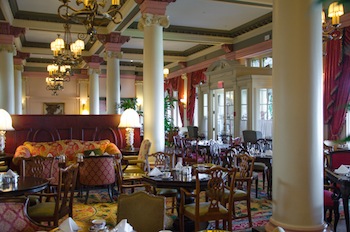 Have you ever wanted to partake in an experience where you would be tended to like royalty? Would you like to take a seat at an Edwardian-style tea party where delicately prepared menu choices are served on magnificently painted fine china and staff members provide the utmost in superb personal service? The illustrious and classical Fairmont Empress Hotel in Victoria, British Columbia, offers these delights in an Afternoon Tea that is truly fit for a king or queen.
Have you ever wanted to partake in an experience where you would be tended to like royalty? Would you like to take a seat at an Edwardian-style tea party where delicately prepared menu choices are served on magnificently painted fine china and staff members provide the utmost in superb personal service? The illustrious and classical Fairmont Empress Hotel in Victoria, British Columbia, offers these delights in an Afternoon Tea that is truly fit for a king or queen. 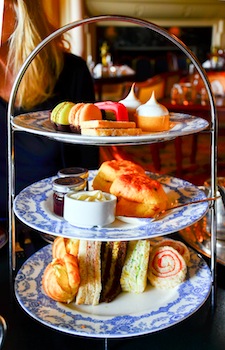 One of the most notable features is the graciousness of the staff. Even though they serve hundreds of guests each day, they move flawlessly about the room as if rehearsed to ensure that each guest is pampered and comfortable. They serve an array of delicate tea sandwiches, croissants, scones, meringues, and berries with cream that are almost too beautiful to eat. However, each morsel is tastefully delicious!
One of the most notable features is the graciousness of the staff. Even though they serve hundreds of guests each day, they move flawlessly about the room as if rehearsed to ensure that each guest is pampered and comfortable. They serve an array of delicate tea sandwiches, croissants, scones, meringues, and berries with cream that are almost too beautiful to eat. However, each morsel is tastefully delicious!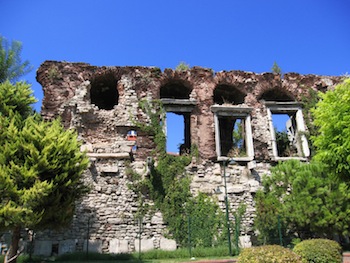 Just as I was on the verge of giving up, I rounded a bend on the coast road and suddenly there it was. This crumbled section of old wall would be as unremarkable as any other were it not for the three huge windows still in place in a recess of the masonry. In their heyday they would have looked out across the Great Palace’s private harbor, protected by two huge lion sculptures which can now be seen in the Archaeological Museum. A few remaining corbels of a long balcony, too, can still be seen at ground level.
Just as I was on the verge of giving up, I rounded a bend on the coast road and suddenly there it was. This crumbled section of old wall would be as unremarkable as any other were it not for the three huge windows still in place in a recess of the masonry. In their heyday they would have looked out across the Great Palace’s private harbor, protected by two huge lion sculptures which can now be seen in the Archaeological Museum. A few remaining corbels of a long balcony, too, can still be seen at ground level.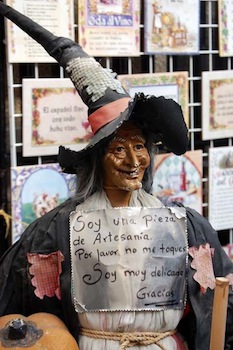 Every year, from October 4th through 12th, the San Froilán Fiesta lights up Lugo, the capital city of Lugo province in Galicia, the northwest region of Spain. Famous bands perform onstage. Puppeteers and street musicians rim plazas or spill along side streets. Artisans sell handcrafts on blankets. A silver cowboy statue springs to life. A witch guards a major shop on a corner. Another witch peers out a window.
Every year, from October 4th through 12th, the San Froilán Fiesta lights up Lugo, the capital city of Lugo province in Galicia, the northwest region of Spain. Famous bands perform onstage. Puppeteers and street musicians rim plazas or spill along side streets. Artisans sell handcrafts on blankets. A silver cowboy statue springs to life. A witch guards a major shop on a corner. Another witch peers out a window. 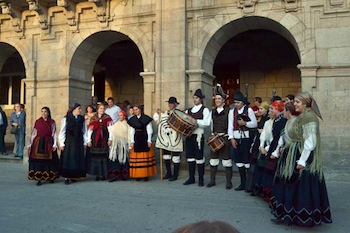 The St. Mary’s Cathedral (or Lugo Cathedral) became a pilgrimage center in the Middle Ages. A chapel is dedicated to San Froilán, patron saint of both Lugo and Leon provinces. A ninth-century hermit and later a bishop, San Froilán founded monasteries in the early days of the reconquista, or re-Christianizing, of Spain.
The St. Mary’s Cathedral (or Lugo Cathedral) became a pilgrimage center in the Middle Ages. A chapel is dedicated to San Froilán, patron saint of both Lugo and Leon provinces. A ninth-century hermit and later a bishop, San Froilán founded monasteries in the early days of the reconquista, or re-Christianizing, of Spain. 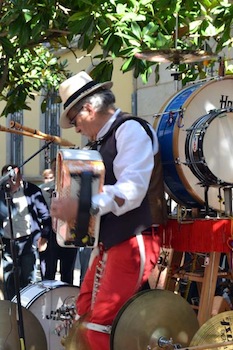 After lunch, we came upon a band rehearsing at the Plaza Santa Maria, playing Galician music with traditional instruments -- four harps, four Galician-style bagpipes (gaitos), four violins, six tambourines, one huge set of drums and a smaller drum, and about eight “lap” organs with handles, as well as castanets and a mouth instrument “twanged” by hand. The music sometimes sounded Irish, sometimes Greek, sometimes Spanish -- and always haunting. That night, we heard the concert all over again, with the orchestra members dressed in style.
After lunch, we came upon a band rehearsing at the Plaza Santa Maria, playing Galician music with traditional instruments -- four harps, four Galician-style bagpipes (gaitos), four violins, six tambourines, one huge set of drums and a smaller drum, and about eight “lap” organs with handles, as well as castanets and a mouth instrument “twanged” by hand. The music sometimes sounded Irish, sometimes Greek, sometimes Spanish -- and always haunting. That night, we heard the concert all over again, with the orchestra members dressed in style.